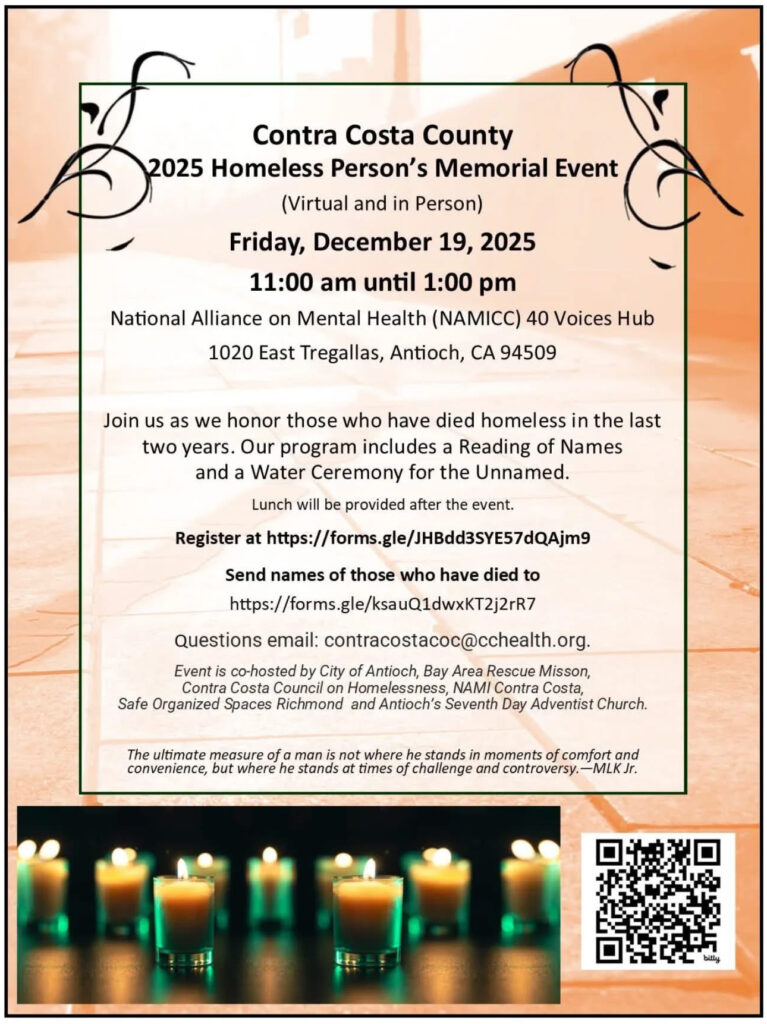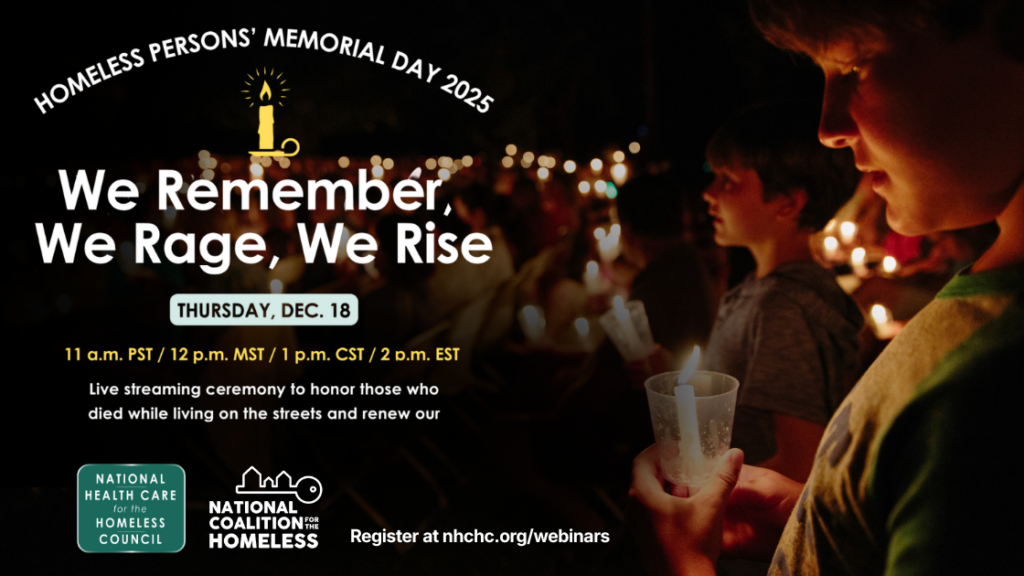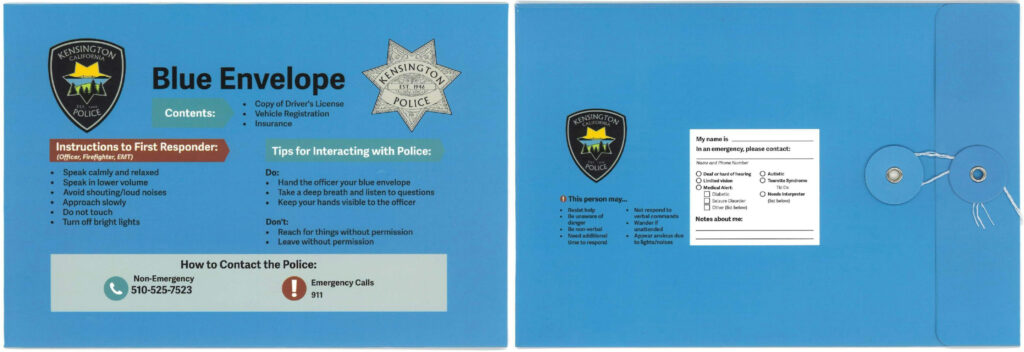Includes Grand Menorah Lighting
By Chabad of Concord
We are excited to announce the 2nd Grand Community Chanukah Festival in Clayton!
We are thankful to have an incredible lineup of entertainment, officials, crafts, and Chanukah excitement that you won’t want to miss.
Chabad of Concord and The City of Clayton have joined forces to bring you a Grand Menorah Lighting & LED juggling show event that promises to be unforgettable! So, get ready to celebrate with us as a community and show your Jewish pride and unity!
Sunday, Dec 21, 4:00 PM
At The Grove – 6110 Center Street in Clayton
- Celebrate Jewish pride and unity this Chanukah with local dignitaries, leaders, and community!
- Enjoy latkes, “The Best Sufganiyot”, hot chocolate & More
- Live Show
- Music videos
- Crafts
- Raffles
- More
Raffle ticket provided with RSVP.
Chanukah is the Jewish eight-day, wintertime “festival of lights,” celebrated with a nightly menorah lighting, special prayers and fried foods. The Hebrew word Chanukah means “dedication,” and is thus named because it celebrates the rededication of the Holy Temple. Chanukah begins on the eve of Kislev 25 and continues for eight days.
Looking forward to a grand time celebrating together!
Free admission- Please RSVP Jewishconcord.com/Clayton.
Special thanks ABL Health Care, Simcha Sisters, the City of Clayton and PJ Library for your partnership!
Read MoreBy Chabad of Concord
We are thrilled to announce that the 7th annual Grand Community Menorah Lighting is finally here!
This year, we are thankful to have an incredible lineup of entertainment, officials, crafts and Chanukah excitement that you won’t want to miss.
Chabad of Concord and The Veranda have joined forces to bring you a grand Menorah lighting event that promises to be unforgettable! So, get ready to celebrate with us as a community and show your Jewish pride and unity!
Thursday, December 18, 4:30 PM
At The Veranda – 2025 Diamond Blvd., Concord
- Celebrate Jewish pride and unity this Chanukah with local dignitaries, leaders, and community!
- Enjoy Chanukah treats
- Live Performance by the award-winning Goofball
- Music videos
- Crafts
- Raffle
Raffle ticket provided with RSVP.
Chanukah is the Jewish eight-day, wintertime “festival of lights,” celebrated with a nightly menorah lighting, special prayers and fried foods. The Hebrew word Chanukah means “dedication,” and is thus named because it celebrates the rededication of the Holy Temple. Chanukah begins on the eve of Kislev 25 and continues for eight days.
Looking forward to a grand time celebrating together!
Free admission- Please RSVP Jewishconcord.com/grand.
Special thanks ABL Health Care & Simcha Sisters for your sponsorship!
For more information visit www.jewishconcord.com or www.facebook.com/chabadofconcord.
Read MoreIncludes Grand Menorah Lighting Ceremony
By Chabad of the Delta
Get ready to light up the night! The Chanukah Festival is happening in Brentwood, Sunday, Dec. 14, 2025, and you won’t want to miss this incredible lineup of fun, food and festivities!
DELICIOUS FOOD: Indulge in traditional, piping-hot latkes and warm, fluffy sufganiyot (donuts)! Plus, keep cozy with our FREE Hot Drink Bar (Hot Cocoa & Spiced Cider)!
AMAZING ACTIVITIES: Test your speed at the Flickering Flame Game (Menorah Whack-a-Mole!), take a spin on the Human Dreidel, and get a festive Glitter Tattoo!
TECH CORNER: See the future of the holiday with a 3D Printed Dreidel Demo!
MAIN STAGE: Join us for the hilarious and astonishing Al Skinner Comedy Magic show at 5:30 PM, followed by the Grand Menorah Lighting Ceremony!
RAFFLE ALERT: Enter to win a one-of-a-kind 3D-printed dreidel! Find the raffle table near the Chanukah Gift Shop. Winners announced after the Menorah Lighting!
Chanukah is the Jewish eight-day, wintertime “festival of lights,” celebrated with a nightly menorah lighting, special prayers and fried foods. The Hebrew word Chanukah means “dedication,” and is thus named because it celebrates the rededication of the Holy Temple. Chanukah begins on the eve of Kislev 25 and continues for eight days.
Join us at the Brentwood Community Center at 35 Oak Street in Downtown.
Don’t wait! RSVP at www.JewishDelta.com/Chanukah.
For more information visit www.facebook.com/ChabadoftheDelta.
Read MoreFor those who have died in the past two years
Watch national ceremony online Dec. 18
By NAMI Contra Costa
Join us for Homeless Persons’ Memorial Day, where we will create a space to remember, honor and celebrate those in our community with a lived experience of homelessness who have died in the past two years. As part of the event, we will be reading their names and stories. You are invited to share the names of people whom you would like to be remembered here: https://forms.gle/ksauQ1dwxKT2j2rR7.
This hybrid (in person and online) event will take place:
Friday December 19, 2025
11:00 am – 1 pm
- Reading of the names: 11:30 am
- Lunch served: 12:30 pm
Physical Address: NAMI CC – 40 Voices African American Holistic Wellness and Resource Hub, 1020 East Tregallas Road, Antioch
Zoom: https://homebaseccc.zoom.us/j/86971795919
Event co-hosted by Antioch Seventh Day Adventist Church, Bay Area Rescue Mission, City of Antioch, Contra Costa Council on Homelessness, NAMI Contra Costa, and Safe Organized Spaces Richmond.
If you have questions, please reach out to contracostacoc@cchealth.org.
National Homeless Persons’ Memorial Day Ceremony (Virtual Attendance)
Please join us from wherever you are on Dec. 18th for a livestream of this year’s Homeless Persons’ Memorial Day ceremony at 11 a.m. PST.
The National Coalition for the Homeless, the National Health Care for the Homeless Council, and the National Consumer Advisory Board, a member network of the Council, encourage our communities to organize or take part in Homeless Persons’ Memorial Day (HPMD) events on or around the winter solstice — the first day of winter and the longest night of the year.
At these events each year, we remember those who have died and we strengthen our resolve to work for a world where no life is lived or lost in homelessness. We state clearly, together with others in scores of communities across the nation, that no person should die for lack of housing.
List of Speakers For the Memorial Event
Register at: 2025 Homeless Persons’ Memorial Day Ceremony Livestream.
About NAMI CC – Support. Educate. Advocate. Outreach.
Mission Statement – To provide support, outreach, education, and advocacy to individuals impacted by mental illness, their families, and the broader community.
NAMI Contra Costa is a 501(c)3 non-profit organization providing outreach, education, support and advocacy to individuals living with mental illness, their families, and the broader community. We have been serving in Contra Costa County and beyond for over 35 years. All our programs are free, so get involved today and help make a difference in your life, others’ lives, and in the local community.
NAMI Contra Costa is an affiliate of the National Alliance on Mental Illness. We are unique in our independence with long history of supporting individuals living with mental illness, their families, and the broader community.
NAMI CC has a commitment to serve the needs of all impacted by mental illness. We have staffed our agency to be reflective of those who are unserved, underserved, and inappropriately served. We have many support groups, classes, and services for these communities. Additionally, to help reach much of the homebound community, we provide almost all of our groups and classes via Zoom, and now more are in-person. So please visit our calendar page for group dates and times.
NAMI Contra Costa was named the 2023 California Nonprofit of the Year.
About the Delta Bay Wellness Hub
NAMI CC is committed to ensuring ALL individuals impacted by mental illness have their needs met and no one is left behind. We, therefore, lifted the 40 Voices Campaign to advocate for an African American Holistic Wellness & Resource Hub to improve outcomes for the African American community. Despite 40 Voices’ successful advocacy for a total of $8.9 million dollars from the Contra Costa Board of Supervisors, we have been asked to wait until 2029 for the physical site of the hub to be realized. We cannot afford to wait. NAMI CC CEO and Founder of the 40 Voices Campaign, Gigi Crowder, decided to move forward with the hub – primarily using her own personal funding and securing donations from others. If you would like to support this important effort, you can Zelle a payment (510-990-2670) or mail in a check (2151 Salvio Street, Suite V, Concord, CA 94520) or simply go to www.namicontracosta.org/donate to make a donation. All donations are tax deductible. Donations of $40 dollars or more will be recognized on a poster as a “Founding Contributor” of the 40 Voices African American Holistic Wellness & Resource Hub at Delta Bay. The renovations have resulted in a beautiful healing space.
For more information, contact: Gigi R. Crowder at (510) 990-2670 or gigi@namicontracosta.org.
Allen D. Payton contributed to this report
Read More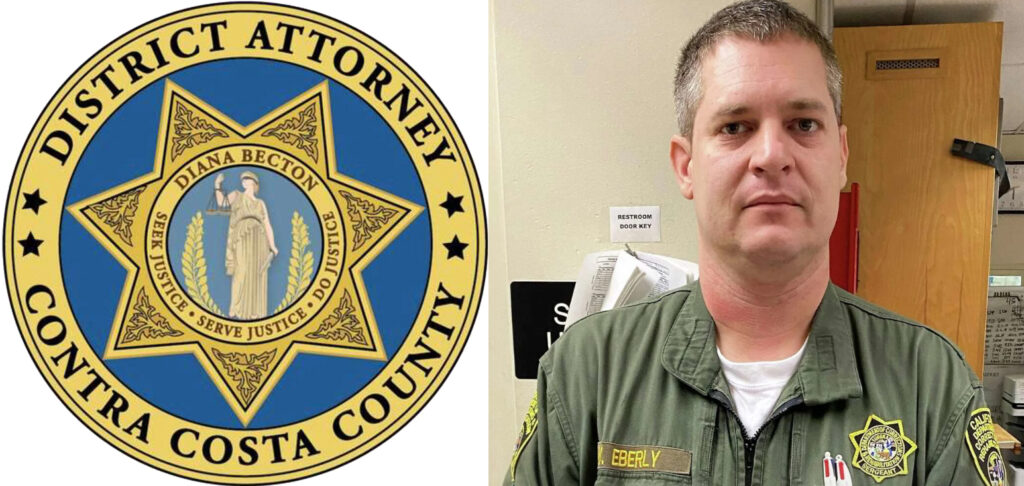
Former San Quentin Prison Correctional Sergeant William Daniel Eberly. Photo: CA Dep’t of Corrections & Rehabilitation
CCDA’s Office “profoundly troubled by the court’s decision”
Family unsure where he’s living after being evicted from trailer on prison grounds in March
“He keeps getting released and it continues to keep going away.” – Family advocate
By Allen D. Payton
As previously reported, 44-year-old Martinez resident, William Daniel Eberly faces multiple felony charges for alleged lewd acts upon children. He was arrested on Oct. 22, 2025, and arraigned, Thursday, Oct. 23, in Martinez on an 11-count complaint that includes forcible lewd acts on a child under 14 and lewd acts on a child aged 14 or 15. Two victims, identified in court documents as Jane Doe #1 and Jane Doe #2, will remain anonymous to protect their privacy.
The alleged offenses occurred between November 1, 2020, and December 12, 2024, in Contra Costa County. Eberly was employed as a correctional sergeant with the California Department of Corrections and Rehabilitation at San Quentin prison at the time of his arrest. Eberly pleaded not guilty to all charges at his arraignment.
Released Pending Trial
According to an advocate for Eberly’s family, who spoke on condition of anonymity, following a pre-trial conference in Martinez Superior Court Thursday morning, Dec. 11, 2025, “he was released pending trial.”
“He hasn’t had anything to do with his children for a very long time. He has four sons with another correctional officer,” the advocate shared.
“A memorandum was sent by San Quentin dated March 20, 2025, by the warden to all employees telling them to stop Eberly at the gate, that he’s not allowed to enter institutional property,” she continued. “He’s been on leave from San Quentin since that date.”
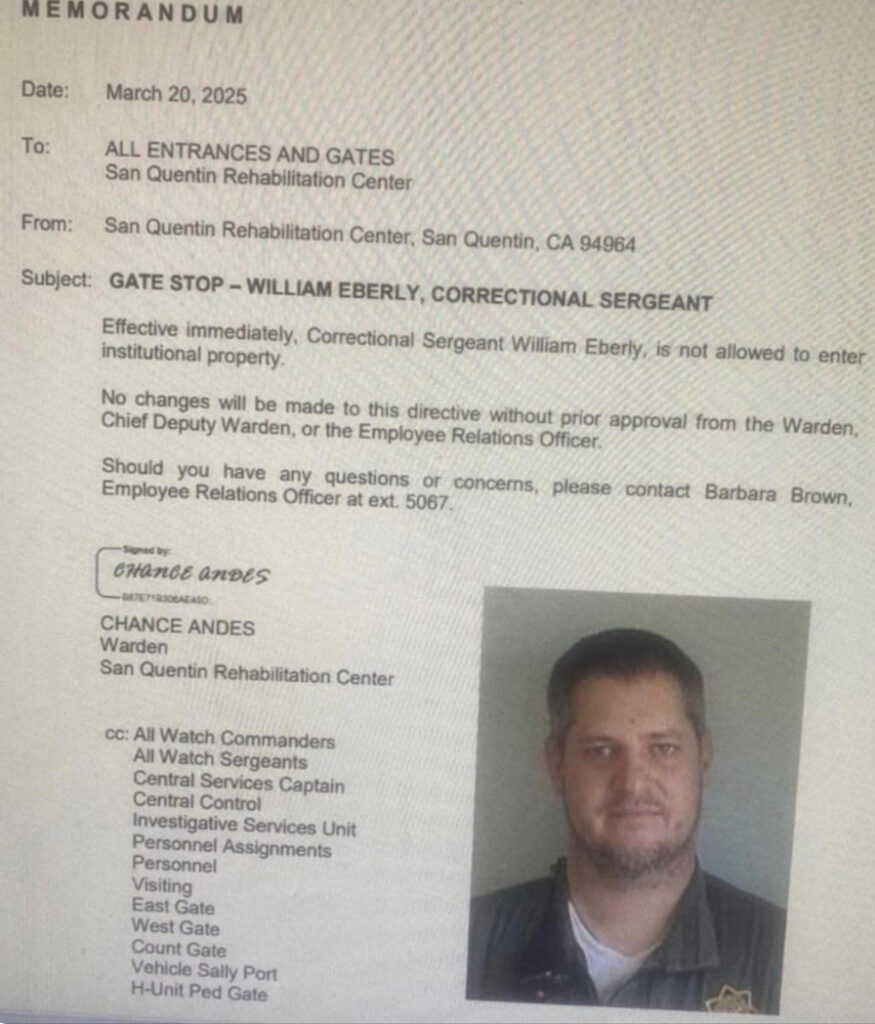
Gate Stop Memorandum dated March 20, 2025, sent by San Quentin Rehabilitation Center Warden Chance Andes to prison staff. Source: Family’s advocate who chose to remain anonymous
“He doesn’t live with either of his ex-wives or his current wife,” the advocated stated. “Nobody knows where he lives. He may be homeless. He doesn’t actually have a residence which is shocking. He was living in a trailer on the prison grounds. But he was told to vacate when he was forced to leave the prison.”
“He was recently granted court-ordered supervised visits with his children,” she said. “But I don’t think he’s seen them in over a year.”
“They first arrested him in March, then let him go because they said they didn’t have enough evidence,” the advocate shared. “This has been going on for like four years, he’s been in and out of custody. He keeps getting released and it continues to keep going away.”
She shared concerns about the children wanting to keep their identities private and out of the public eye.
“People were calling the schools where the kids attend probably to see if he was there picking them up,” the advocate said. “They don’t know he’s been arrested or anything. They don’t need to know. They’re all really young.”
She asked the public not to post photos of the children.
“The reports about him online are wrong,” she also shared. “He’s not Latino. He’s white.”
Asked if she knows Eberly, the advocate said, “Yes, I know him. “But I haven’t seen him in over a year when he last saw the kids.”
“He was always a stickler for the rules. So, this is all very shocking,” she added.
Asked if she attended Thursday’s hearing, the advocate responded, “No. They barred all potential witnesses that the prosecution might call.”
Asked what date has been set for the trial she responded, “We do not know yet.”
Eberly was “released without having to post bail. No ankle monitor. No bail. Released on own recognizance,” the advocate repeated.
Contra Costa DA’s Office “Profoundly Troubled by the Court’s Decision”
Asked about Eberly’s release, the Contra Costa District Attorney’s Office issued the following statement regarding The People v. William Daniel Eberly Court ruling on 12/11/25:
“Following the presentation of evidence at the preliminary hearing, the court held the defendant William Eberly to answer on 11 felony counts of Penal Code section 288(b)(1), forcible lewd acts upon two child victims.
“During the ruling, Eberly’s defense counsel requested that the court release him from custody on his own recognizance, and a visiting judge in Contra Costa County granted that request.
“The District Attorney’s Office is profoundly troubled by the court’s decision to release Eberly from jail custody.
“In addition to the seriousness of the charged offenses and the clear danger the defendant poses to the community, the Deputy District Attorney prosecuting the case cited several additional factors weighing against release, including:
- Prior arrests in 2013 for inflicting injury on a child, and in 2020 for inflicting injury on a spouse or cohabitant.
- The defendant’s abuse of a position of trust to harm two minor victims.
“Despite these objections, the court reasoned that because the defendant had no prior charges formally filed with the court and because he is a veteran, release was appropriate.
“The District Attorney’s Office will continue working diligently to pursue all available legal options to seek justice for the victims, protect the community, and hold the defendant accountable.”
As previously reported, according to localcrimenews.com, Eberly was previously arrested in 2013 by the Alameda County Sheriff’s Office for Contempt of Court: Disobeying a Court Order/Process and in 2020 by the Marin County Sheriff’s Office for inflicting corporal injury on a spouse or cohabitant.
Case No. 01-25-03633 | The People of the State of California v. William Daniel Eberly
Read MorePart of growing statewide and national effort to help facilitate smoother interactions between law enforcement officers and individuals with Autism Spectrum Disorder during traffic stops.
By Lt. Amit Nath, Kensington Police Department
The Kensington Police Department is launching its new Blue Envelope Program, a voluntary initiative designed to make traffic stops and other police contacts safer and less stressful for drivers with autism, intellectual and developmental disabilities, anxiety, dementia and other communication differences.
With the launch of this program, Kensington becomes one of the first police agencies in the Bay Area to offer a dedicated Blue Envelope option for drivers, joining a growing movement across California and the United States to better support neurodivergent community members during interactions with law enforcement.
 The Blue Envelope is a clearly marked, bright blue envelope that participants keep in their vehicle. Inside, they can store their driver’s license, registration, proof of insurance, emergency contact information, and a brief description of their preferred communication style (for example, needing extra time to answer questions or preferring written instructions). During a traffic stop, drivers can hand the envelope to the officer s a quiet, respectful way to signal that they may need additional patience, clear language, or other accommodations.
The Blue Envelope is a clearly marked, bright blue envelope that participants keep in their vehicle. Inside, they can store their driver’s license, registration, proof of insurance, emergency contact information, and a brief description of their preferred communication style (for example, needing extra time to answer questions or preferring written instructions). During a traffic stop, drivers can hand the envelope to the officer s a quiet, respectful way to signal that they may need additional patience, clear language, or other accommodations.
“The Blue Envelope Program is about respect, understanding, and safety for everyone,” said Chief Mike Gancasz. “For some members of our community, a traffic stop can be overwhelming. This program gives drivers a simple tool to communicate their needs, and it gives our officers helpful guidance so they can respond with patience and compassion.”
Part of Growing Statewide & National Effort
Blue Envelope initiatives began on the East Coast, notably in Connecticut, and have since spread to multiple states, including Virginia, New York, Arkansas and others, where state agencies and local departments use the blue envelope as a standardized tool to support drivers with autism and similar conditions during police encounters.
In California, sheriff’s offices and police departments in communities such as San Bernardino County, San Diego County, Riverside County, Placer County, Sutter County, Ventura County, and several city departments have adopted Blue Envelope programs or similar models—often in partnership with regional centers and autism advocacy organizations.
Kensington’s program draws on these best practices while tailoring the materials and training to the unique needs of a small, community-focused police department.
National Public Safety Alliance for Individuals with Disabilities (NPS-AID) Supports the Blue Envelope Program
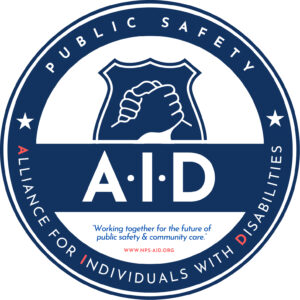 Supported by the National Public Safety Alliance for Individuals with Disabilities, the “Blue Envelope Program” is an initiative that is not mandated, but adopted by many law enforcement agencies across the U.S., designed to help facilitate smoother interactions between law enforcement officers and individuals with Autism Spectrum Disorder (ASD) during traffic stops.
Supported by the National Public Safety Alliance for Individuals with Disabilities, the “Blue Envelope Program” is an initiative that is not mandated, but adopted by many law enforcement agencies across the U.S., designed to help facilitate smoother interactions between law enforcement officers and individuals with Autism Spectrum Disorder (ASD) during traffic stops.
The NPS-AID is a voluntary program designed to assist individuals with disabilities during emergencies by providing first responders with critical information.
Any time a disabled community partner joins the “National Public Safety Alliance for Individuals” program and resides in a NPS-AID supporting chapter jurisdiction where the “Blue Envelope Program” is in use, the oversight agency has the ability to quickly send notice via the NPS-AID system to the member which will provide the participant with information about the program and how to enroll. This notice will be delivered via email once the member completes their NPS-AID membership enrollment.
All agencies that adopt the “Blue Envelope Program” create thier own enrollment process and the exact steps can vary from agency to agency since there is no centralized program or support system for Blue Envelope. All supporting NPS-AID chapter agencies are provided special access to essential resources to help agencies create, launch, and manage their own “Blue Envelope Program”, such as envelope templates, draft policies and more, reducing the burden and simplifying the process.
How Residents Can Participate
- Cost: The program is free and completely voluntary.
- Privacy: No registration is required, and KPD does not collect or store medical information; all details remain with the driver and their family.
- Where to get an envelope:
o In person at the Kensington Police Department lobby located at 10940 San Pablo, El Cerrito, CA 94530
o From a uniformed Kensington Police Officer or Kensington Police Volunteer
o At community events and outreach activities throughout Kensington
Available Outreach Materials
The following items are available free of charge at the Kensington Police Department and other participating locations:
- Blue Envelope Program Brochure
- Blue Envelope
- Wallet Information Card
- Lanyards
- Seatbelt Covers
- Buttons
- Key Chains
- Wristbands
- Stickers
These materials help signal participation in the program and provide quick access to important information during a law enforcement interaction.
Residents can learn more about how the program works, download information, and see example materials by visiting: www.kppcsd.org/blue-envelope-program-kensington.
Allen D. Payton contributed to this report.
Read MoreSince April 2023 ALPR contributed to over 270 people arrested, over 250 vehicles recovered, more
By Richmond Police Department
The Richmond Police Department is committed to transparency and protecting the information we collect to keep our community safe. We want to share an update regarding our Automated License Plate Reader (ALPR) system operated by Flock Safety.
Since its inception in April 2023, ALPR data has become an essential investigative tool for both patrol officers and detectives conducting follow-up investigations, providing significant public-safety benefits. ALPR data has directly contributed to:
- The arrest of over 272 individuals involved in criminal activity
- The identification of a suspect vehicle in 12 separate homicide cases
- The recovery of over 258 stolen vehicles
- More than 889 cases where ALPR information directly led to the identification of a suspect or suspect vehicle
- Alerted officers to the presence of over 6,670 stolen vehicles in our city
- Alerted officers to the presence of over 759 vehicles that were wanted for felony crimes in our city
These outcomes demonstrate how the responsible use of technology helps us solve crimes, locate dangerous offenders, and support victims. Without the ALPR data provided by Flock, many of these cases, including murder cases, would most likely remain unsolved.
Earlier this year, Flock Safety notified us of a system configuration error that allowed certain external law enforcement agencies to run very limited, specific license-plate searches that could have revealed small portions of Richmond’s ALPR data. This was not full-system access and affected only narrow, plate-specific queries.
The issue was unintentional and was disabled immediately upon discovery. ALPR data is only stored for 30 days, and at this time, we have no evidence that any outside agency viewed or misused Richmond’s data, including for immigration enforcement. Because multiple agencies were affected, we temporarily turned off our ALPR system until Flock Safety provides verified safeguards and assurances to prevent future issues.
The Richmond Police Department will continue to use technology responsibly and transparently, in a manner that aligns with our community’s expectations and enhances our ability to solve crimes and keep residents safe. We remain committed to protecting your privacy, being transparent, and using technology in ways that reflect Richmond’s values and expectations. We look forward to implementing enhanced safeguards and reactivating our ALPR system so it can continue to provide valuable investigative leads, hold offenders accountable, and deliver justice for victims and their families.
Read MoreBy Scouts Troop 152, Oakley, CA
Oakley Community — We Need Your Help!
We’ve had so many customers tell us they thought our tree lot was closed this year and only found us by chance at our new location — and we don’t want anyone to miss out!
We have lots of beautiful trees ready to go, and 100% of proceeds support our local Scouts (and are tax-deductible).
Will you help us spread the word? Share this post, tell a friend and come visit us at our new spot.
Thank you for supporting our Scouts and keeping this tradition alive!
**NEW LOCATION** 4246 Empire Avenue in Oakley at Revive Church. OPEN 7 days a week. Weekdays 5-8pm, Weekends 10am-8pm.
Read MoreGift Giveaway Dec. 20
By The Richmond Fire & Police Toy Program
Each year, Richmond Firefighters and Police Officers come together to bring holiday cheer to families in need through the annual Toy Program. This special event helps ensure that every child can experience the joy of the season.
The joy of watching kids opening their presents is something most parents look forward to at Christmas. Sadly, some families don’t get to see that joy because they can’t afford presents or even a nice meal.
West County families need your help. Many families struggle to make ends meet during the holidays. You can help a family having tough times. Please consider making a tax-deductible donation.
This Saturday, Dec. 13, a Benefit Raffle will be held at St. David of Wales Catholic School, located at 871 Sonoma Street, Richmond to support the Program. We will have food, games and more. Please bring new, unwrapped gifts.
The gift giveaway will take place on Dec. 20th at DeJean Middle School at 3400 MacDonald Avenue in Richmond, beginning at 9:00 a.m. (Sign-ups to receive gifts have already ended).
About The Richmond Fire and Police Toy Program
In 1989, Richmond firefighter Rod Woods (now retired) saw the need in the community and organized a small local toy drive to help families in need. At the same time and separately, the Richmond Police Department also saw the need in the community, only their focus was on providing families with food for that special meal and beyond.
After many years of growing their separate programs and having outgrown the space at the Booker T. Anderson Community Center where the event took place, Fire and Police decided to unite as one entity and file for non-profit status so they could get corporate sponsors to help more families. Chevron Fire stepped up and continues their support. El Cerrito Fire also joined for a time.
The E.M. Downer YMCA stepped up to offer a larger space in their gym, as well as providing support for the sign-ups, administrative support and smiles all around. The program went from serving over 500 families with toys and food to over 1,500 with the addition of a chance to win a donated bicycle.
Corporate sponsors such as Chevron, Mechanics Bank, Richmond Sanitary, Richmond Rotary, Sims Metal, Costco, the Courtyard by Marriott and many others stepped up to the plate to offer not only money, but volunteers who helped with toy bagging, food bagging and at the event itself, handing out bags, helping to carry bags, handling the bike giveaway and much more. There were bikes to build, trucks to drive to pick up toys, bikes, food and chicken. Fire and Police, along with community volunteers, came together to make it happen. The Richmond Police Explorers helped with the logistics and keeping the lines in order, and also with assisting those needing help carrying the bags of toys and food.
Rod Woods was the heart and soul of the program. His outgoing personality, ability to talk people into giving support in many forms is sorely missed.
For more information or to make a donation visit https://richmondfireandpolicetoyprogram.com, call 510-375-3477 or email info@richmondfireandpolicetoyprogram.com.
Read MoreBy Danielle Navarro, Assistant City Manager, City of Oakley
The San Jose Sharks promo team will be at Oakley on Ice this Saturday, December 13th, from 2:30 to 8:30 pm. There will be interactive games, a prize table, photo ops and more.
Oakley on Ice skating rink is located at Norcross Lane and Main Street behind the Mercantile Building. For more information visit https://oakleyonice.com/.
Read More













